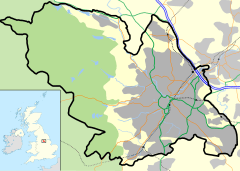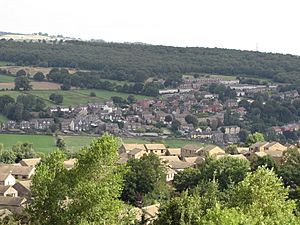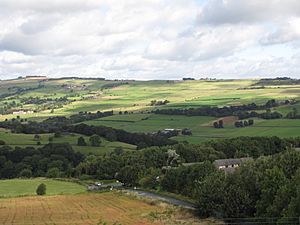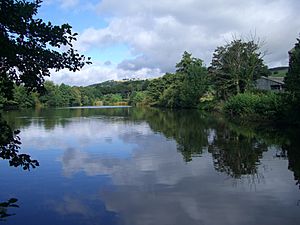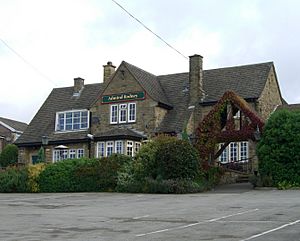Loxley, South Yorkshire facts for kids
Quick facts for kids Loxley |
|
|---|---|
| Metropolitan borough | |
| Metropolitan county | |
| Region | |
| Country | England |
| Sovereign state | United Kingdom |
| Post town | SHEFFIELD |
| Postcode district | S6 |
| Dialling code | 0114 |
| Police | South Yorkshire |
| Fire | South Yorkshire |
| Ambulance | Yorkshire |
| EU Parliament | Yorkshire and the Humber |
| UK Parliament |
|
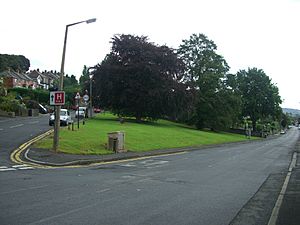
Loxley is a village and part of the city of Sheffield, England. It's a long community that stretches along the River Loxley and the B6077 road (Loxley Road) for almost 4 kilometers. Loxley goes from its edges with Malin Bridge and Wisewood all the way west to Stacey Bank, a small group of houses near Damflask Reservoir.
The center of Loxley is where Rodney Hill and Loxley Road meet. Here you'll find the old village green. This spot is about 5 kilometers northwest of Sheffield city center. Loxley is part of the Stannington area in Sheffield.
Loxley used to be a village in the West Riding of Yorkshire. It became part of Sheffield in 1974 because of new local government rules. Today, Loxley is mostly homes, but it used to have factories and workshops. Much of the Loxley Valley is protected as green belt land, which means it's kept natural and open.
The name Loxley comes from old English words. "Lox" meant 'lynx' (a type of wild cat), and "leah" meant "glade" (an open space in a forest). In 2011, Loxley had 1,775 people living there.
Contents
A Look Back at Loxley's Past
Early Days and Hunting Grounds
Loxley was once mostly open moorland. After the Normans took over England in the 11th century, a large area called Loxley Chase was set aside for hunting by the Norman lords. The Loxley valley was also a big forest.
Over time, people started farming more in the valley. Loxley slowly grew with farms and shared land.
The Legend of Robin Hood
The big forest of Loxley Chase once reached as far as Nottinghamshire in the 1100s, connecting with Sherwood Forest. Because of this, Loxley is one of the places said to be the birthplace of Robin Hood. Some believe Robin of Locksley, or Robert Locksley, was born here in 1160.
An old survey from 1637 mentions "Little Haggas Croft... where Robin Hood was borne." This spot was near where Normandale House is today on Rodney Hill. Old songs and stories, like those in the Child Ballads, and even a novel by Sir Walter Scott called Ivanhoe, suggest that Robin Hood might have come from South Yorkshire.
In 2020, the local Member of Parliament, Olivia Blake, even said in her first speech to Parliament that her area, Sheffield Hallam, has a "very long history of social justice" because of the Robin Hood legend in Loxley.
Factories and Farms Grow
Factories started to appear in Loxley in the mid-1600s. The first mills were built on the fast-flowing River Loxley. These mills made steel and iron. Places like Loxley Steel Works and Little Matlock Rolling Mill became important. Many of the ponds that powered these mills are still there today. They are now home to fish and other wildlife.
In the 1800s, the Loxley Valley became famous for making special bricks called refractory bricks. These bricks were used to line furnaces in the growing Sheffield steel industry. They were made from local clay and a type of sandstone called ganister. Many mines opened to get these materials.
Several companies, like Bramalls and Thomas Marshall and Co., made these bricks. They were used all over the world. However, making these special bricks stopped in the 1990s. This was because new ways of making steel were invented, and the British steel industry started to shrink.
Farming also grew in the Loxley Valley. A law passed in 1789 allowed moorland to be turned into grassy fields. These new fields were then fenced off with straight dry stone walls and new roads.
The Great Sheffield Flood
Loxley suffered a terrible disaster on March 11, 1864. The wall of the Dale Dike Reservoir broke, causing the Great Sheffield Flood. In Loxley, 17 people died, including five members of the Chapman family.
Most of the factories and mills in the area were destroyed or badly damaged. But they were quickly rebuilt using money from the Water Company.
Building More Homes
Many new homes started to be built in Loxley between 1905 and the start of the First World War. More houses were added on Rodney Hill and Loxley Road. After the Second World War, many Council houses were built in the area.
Loxley Today
Facts and Figures
Today, Loxley has 1,828 people living in 753 homes. Most of these homes (82.6%) are owned by the people living in them. About 12.5% are rented from the local council. A large number of homes (76%) in Loxley are either detached (stand-alone) or semi-detached (two homes joined together). This is much higher than the average for Sheffield.
Places to See and Visit
Loxley doesn't have a big shopping area. Most people go to Hillsborough to shop. There are three pubs in the area. The most famous is the Admiral Rodney. It's named after George Brydges Rodney, 1st Baron Rodney, a naval hero who won a big battle in 1782. The current Admiral Rodney pub was built in 1957. The Nag's Head is in the small area of Stacey Bank, and the Wisewood Inn is in the Normandale area.
Loxley no longer has any churches. Loxley Methodist Church closed in 2012. The Loxley United Reformed Church, a very old building from 1787, closed in 1993. It was badly damaged by fire in 2016 and is now an empty shell.
There is one school in Loxley: Loxley Primary School. It opened in 1911 and is on Rodney Hill. It has over 200 students aged 4 to 11. Older students from Loxley go to Bradfield School in Worrall.
The Old Factory Site
The land where the Hepworth's factory used to be was bought by a company that builds houses. They wanted to build 500 homes there in 2006. However, many local groups, like the Loxley Valley Protection Society, are against these plans. As of 2020, the site is still an empty, unused industrial area.
Fun and Green Spaces
Loxley has a recreation ground on Loxley Road, which is the main public open space. Just north of the village is Loxley Common. This is an old area of common land that is now looked after by Sheffield City Council. The common has heath land (open land with small shrubs) and trees. The southern parts of the common, which go down to the Loxley Valley, have rocky cliffs and thick woodland.


